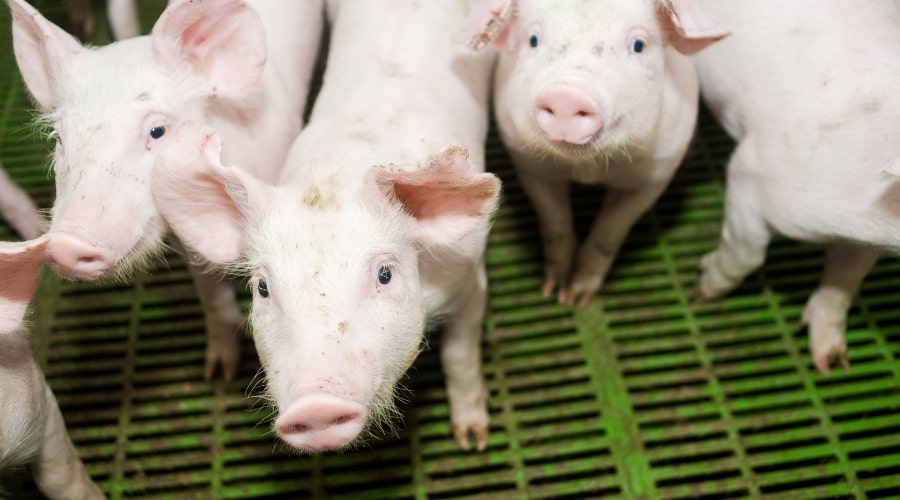Avoiding common mistakes in pig farming is essential for success. These errors can affect productivity, animal health, and overall profitability. Let’s discuss the key mistakes to avoid and how to manage your pig farming operation effectively.
Poor Housing and Overcrowding
Inadequate housing is a common mistake. Pigs need well-ventilated, clean, and dry spaces. Overcrowding leads to stress, which affects growth rates and increases disease risks. Each pig should have enough space to move, rest, and access feed and water comfortably.
Ensure proper drainage and regular cleaning of pig pens to prevent health issues. Poorly maintained pens can lead to respiratory diseases and infections. Plan your housing layout to separate different age groups to avoid bullying and competition for resources.
Invest in sturdy, easy-to-clean materials for pen construction. This reduces long-term maintenance costs and ensures a hygienic environment for your pigs.
Improper Feeding Practices
Feeding pigs an unbalanced diet is a significant issue. Pigs require a mix of protein, energy, vitamins, and minerals to grow efficiently. Overfeeding or underfeeding can lead to poor weight gain, health problems, and financial losses.
Use high-quality commercial feed or formulate your own if you have the expertise. Include kitchen or farm waste cautiously, ensuring it’s free from contaminants or harmful substances. Feed pigs according to their age and purpose, such as breeding, fattening, or lactating.
Provide clean, fresh water at all times. Dehydration directly impacts growth and health. Install automatic drinkers to reduce labor and ensure consistent water availability.
Ignoring Health Management
Neglecting health management is one of the most costly mistakes in pig farming. Pigs are susceptible to diseases like swine fever and foot-and-mouth disease, which can spread rapidly in a poorly managed herd.
Develop a vaccination schedule and follow it strictly. Work with a veterinarian to create a comprehensive health plan. Quarantine new pigs for two weeks before introducing them to the main herd to prevent disease outbreaks.
Regularly inspect pigs for signs of illness, such as reduced appetite, lethargy, or skin lesions. Address health issues immediately to prevent them from affecting the entire herd. Maintain biosecurity measures, such as disinfecting equipment and restricting farm access to essential personnel only.
Poor Breeding Practices
Breeding without a plan often results in low-quality piglets. Avoid using unfit or unhealthy pigs for reproduction, as this affects the productivity and health of the offspring.
Select breeding stock with strong genetics. Choose pigs that show good growth rates, fertility, and disease resistance. Keep detailed breeding records to monitor performance and avoid inbreeding, which leads to health and growth issues.
Ensure that sows receive proper care during gestation and farrowing. Provide a comfortable and quiet space for farrowing to minimize stress and ensure piglet survival.
Ineffective Waste Management
Improper handling of pig waste leads to environmental and health problems. Accumulated waste attracts pests, causes foul odors, and contaminates water sources.
Implement a waste management system. Options include composting, biogas production, or using waste as fertilizer. Properly dispose of dead animals to prevent disease spread. Maintain cleanliness in and around the farm to promote a healthier environment.
Poor Financial Planning
Lack of financial planning often causes farms to fail. Overestimating profits or underestimating costs leads to financial stress. Create a realistic budget that accounts for feed, health care, labor, and equipment.
Keep detailed records of expenses and income. Monitor feed costs and adjust your feeding strategies to stay within budget. Plan for unexpected expenses, such as veterinary emergencies or market price fluctuations.
Checklist for Avoiding Common Pig Farming Mistakes
- Build well-ventilated, clean, and spacious housing.
- Provide a balanced diet tailored to the pigs’ age and purpose.
- Maintain a consistent water supply.
- Follow a strict vaccination and health management schedule.
- Use high-quality breeding stock and monitor performance.
- Implement a sustainable waste management system.
- Develop and follow a detailed financial plan.
By addressing these common mistakes, you can significantly improve the productivity and profitability of your pig farming operation. Consistent effort and attention to detail ensure long-term success.


